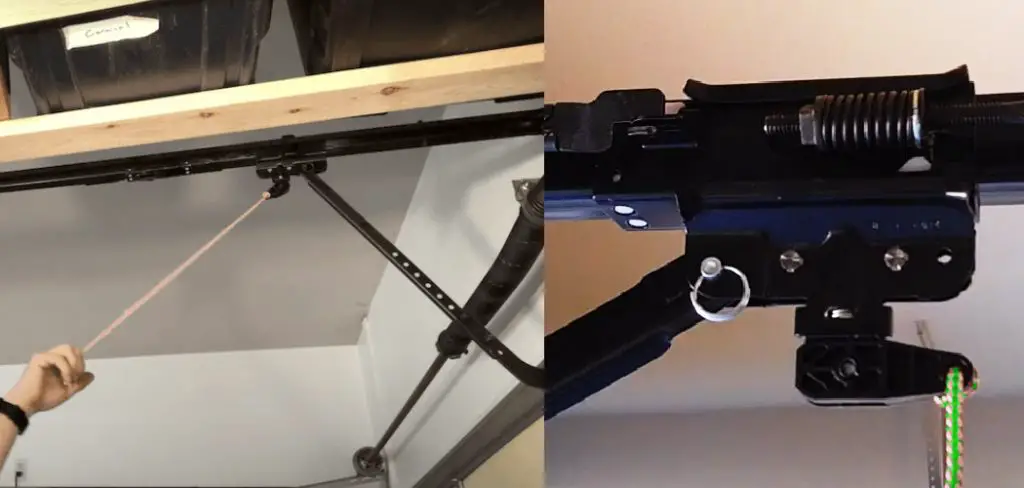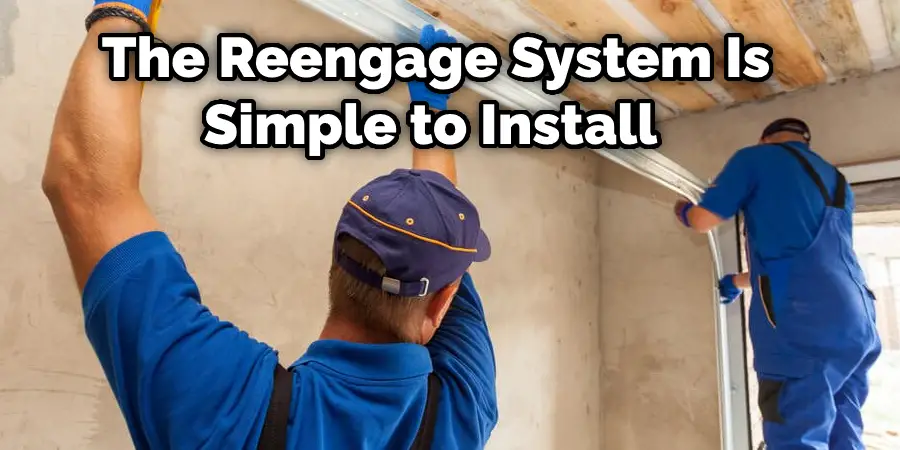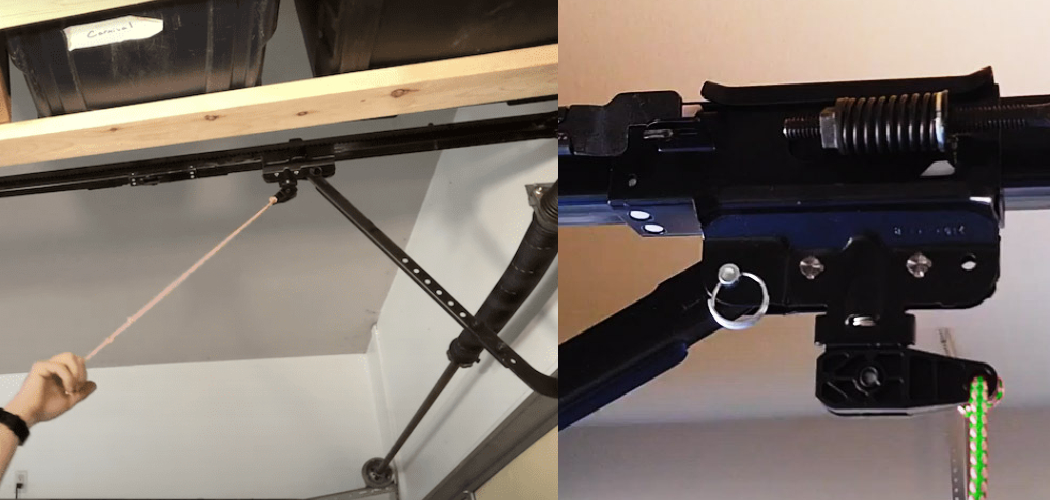Has your garage door become difficult to open recently? Does it feel like something is blocking the way? If so, don’t worry – you’re not alone. Many homeowners find themselves in this situation, and fortunately, there is a simple solution. In this blog post, we’ll teach you how to reengage garage door tracks so that your garage door can move freely again. Keep reading for tips and tricks!

Why Should You Reengage Garage Door?
Homeowners often take their garage doors for granted, but these essential pieces of equipment require regular maintenance to function properly. Over time, springs and hinges can become worn, affecting the door’s balance and making it more difficult to open and close.
In addition, the tracks that the door travels along can become bent or misaligned, preventing the door from opening and closing smoothly. Reengaging your garage door on a regular basis can help to prevent these problems and keep your door functioning like new.
The process is simple and only takes a few minutes, but it can save you time and money in the long run by extending the life of your garage door.
Safety Measures:
Before attempting to reengage your garage door, it’s important to take some safety precautions. First and foremost, make sure that everyone in your household is aware that you’ll be working on the door. Additionally, make sure any pets or children are kept away from the area.
It’s also a good idea to wear gloves and eye protection while working on the door, as there may be sharp edges or debris that could cause injury. And finally, disconnect the power to your garage door opener to prevent any accidents while working on the tracks.
Needed Materials:
To reengage your garage door, you’ll need a few basic materials. These include:
A Ladder or Step Stool:
You’ll need to access the tracks, so a ladder or step stool will come in handy. Make sure it is stable and secure before using it.
A Pry Bar:
This will be used to gently bend any misaligned tracks back into place.
Lubricant:
To keep your garage door running smoothly, you may want to lubricate the tracks and rollers after reengaging them.
How to Reengage Garage Door 9 Step-by-Step Guide
Step 1: Clean the Tracks and Rollers
If your garage door isn’t opening or closing smoothly, the first thing you should do is clean the tracks and rollers. Over time, these can become covered in dirt and grime, making it difficult for the door to move. Use a rag and some soapy water to wipe down the tracks, then use a vacuum to remove any debris from the rollers.
You may also want to lubricate the tracks and rollers at this time using a silicone-based lubricant. This will help the door move more smoothly along the tracks. It’s important to avoid using WD-40 or other petroleum-based lubricants, as these can attract dirt and debris and cause more problems in the long run.
Step 2: Apply Lubricant to The Tracks and Rollers:
Once you’ve cleaned the tracks and rollers, it’s time to lubricate them. This will help the door to move more smoothly and prevent further damage. Apply a silicone-based lubricant to the tracks and rollers, avoiding getting any on the floor beneath the door.
You may also want to apply lubricant to the hinges and other moving parts of the door, as these can become stiff over time. The lubricant will help to keep them functioning properly. You can also use a rag to wipe away any excess lubricant.
Step 3: Adjust The Tracks
If your garage door tracks are bent or misaligned, this can prevent the door from opening and closing properly. To fix this, you’ll need to adjust the tracks. First, loosen the bolts that hold the tracks in place, then tap the tracks gently with a mallet until they’re straight. Once you’ve done this, tighten the bolts back into place.
It’s important to only make small adjustments at a time, as you don’t want to bend the tracks too far in the opposite direction. You may need to repeat this process a few times until the tracks are aligned properly.
Step 4: Check for Any Damage
Once you’ve finished re-engaging your garage door, it’s important to check for any damage. Look for any cracks or chips in the tracks or rollers, and make sure that the door opens and closes smoothly. If you notice any damage, be sure to repair it as soon as possible to prevent further issues.
You may also want to visually inspect the springs, cables, and other components of your garage door, as these can become damaged over time and affect the door’s performance. It’s always better to catch and fix any issues early on rather than wait for them to become bigger problems.
Step 5: Check the Safety Sensors
Before you use your garage door, it’s important to check the safety sensors. These are located at the bottom of the door opening and are responsible for preventing the door from closing if something is in the way. To test them, place an object in front of the door, then try to close it.
The door should stop and reverse when it comes into contact with the object. If it doesn’t, there may be something wrong with the sensors, and they’ll need to be replaced.
Step 6: Test The Door
Once you’ve completed all of the above steps, it’s time to test your garage door. Open and close it a few times to make sure that it’s moving smoothly. If everything seems to be working properly, then you’re all done!

You may want to re-engage your garage door on a regular basis, such as once a month or every few months, to keep it functioning properly. This will help prevent any major issues from occurring and save you time and money in the long run.
Step 7: Call a Professional
If you’re having difficulty re-engaging your garage door or if you notice any damage, it’s always best to call a professional. They can help diagnose the problem and make sure that your door is functioning properly.
It’s also important to have your garage door regularly maintained by a professional to catch any potential issues and keep it running smoothly. With regular maintenance, you can avoid unexpected repairs and extend the life of your garage door.
Step 8: Safety First
Remember to always prioritize safety when working on your garage door. If you’re unsure about something or if any part of the process seems dangerous, stop and call a professional for assistance. It’s better to be safe than sorry.
Additionally, always read and follow the instructions provided by the manufacturer for your specific garage door model. You may also want to wear protective gear, such as gloves and safety glasses while working on your door.
Step 9: Prevention is Key
Preventing garage door issues before they happen is a crucial part of maintaining your garage door. Regularly cleaning and lubricating the tracks and rollers, as well as scheduling professional maintenance, can help prevent any major problems from occurring.
Also, be mindful of how often you open and close your garage door to avoid excessive wear and tear. Using your garage door as a main entrance to your home may cause it to wear out faster and require more frequent re-engagements, so consider using another entrance when possible.
Now that you know how to reengage garage door, you can keep your door in good working order for years to come. This simple maintenance task only takes a few minutes but can save you time and money in the long run. So be sure to add it to your regular home maintenance routine!
How Do I Manually Reengage My Garage Door?
If your garage door opener is working, but the door doesn’t open when you press the button, the most likely culprit is a disengaged door. This means the chain or belt that connects the opener to the door has come off, or the trolley that moves the opener has come loose from its track. In either case, you’ll need to reengage the door manually.
Start by disconnecting the opener from the power source. Then, locate the release handle on the side of the door and pull it to disengage the door from the opener. Once the door is disengaged, you can open and close it manually. Next, reconnect the opener to the power source and press the button to reengage the door.
The door should open and close as usual. If it doesn’t, check to make sure the chain or belt is properly aligned and that all of the tracks are clear of any obstructions.
What Is Reengage Garage Door?
Reengage Garage Door is a cutting-edge garage door opener that uses the latest wireless technology to provide a safe, secure, and convenient way to open and close your garage door.
The system comes with two wireless remote controls that can open and close the door from up to 100 feet away, making it perfect for those who have an attached garage or live in an apartment complex. The Reengage system also includes a keychain remote that can open the door from your car, making it even more convenient.
The keychain remote also has a built-in LED light that makes it easy to find in the dark. In addition, the Reengage system comes with a backup battery that will keep the system operational for up to three days in the event of a power outage.
The Reengage system is simple to install and has everything you need to get started, including detailed instructions. With its cutting-edge features and ease of use, the Reengage Garage Door opener is the perfect solution for looking for a safe, secure and convenient way to open and close their garage door.
Do You Need to Take Professionals Support?
While reengaging your garage door is a relatively simple task, it’s always best to seek professional help if you have any doubts or concerns. They can ensure that the door is properly aligned and functioning correctly, avoiding potential safety hazards.
Additionally, regular maintenance from a professional can extend the life of your garage door and prevent unexpected repairs. So while you may be able to reengage your garage door manually, it’s always a good idea to have a professional inspect and maintain your door on a regular basis. So, if you’re unsure or experiencing any difficulties, don’t hesitate to call in the experts. Your safety and the proper functioning of your garage door should always be the top priority.
How Much Could It Cost?
The cost of reengaging your garage door will vary depending on the specific issue and whether you choose to do it yourself or hire a professional. If you plan on doing it yourself, the only cost will be for any necessary tools or supplies.
However, if you choose to hire a professional, the cost will depend on their hourly rate and any additional charges for parts or services. It’s always a good idea to get a quote from the professional before they begin any work so you can have an idea of the cost upfront.
In some cases, your garage door may be covered under your home warranty, which could cover all or part of the cost of reengaging it. Check with your warranty provider to see if this is a possibility for you.
Additional Tips:
- Regularly clean and lubricate the tracks and rollers of your garage door to prevent it from getting stuck or making loud noises.
- Schedule professional maintenance at least once a year to ensure that all parts of your garage door are functioning properly.
- Consider using another entrance to your home instead of constantly using your garage door to avoid excessive wear and tear.
- If you experience any difficulties or have concerns about reengaging your garage door, seek professional help.
- Regularly inspect and maintain your garage door to avoid costly repairs and ensure safety.
- Don’t forget to disconnect your opener from the power source before manually reengaging your garage door. Safety first!
- Read and follow all instructions provided by the manufacturer for your specific garage door model.
- If your garage door is making unusual noises or seems to be operating differently than usual, don’t hesitate to seek professional help. Unusual sounds and behaviors could indicate a larger issue that requires expert attention.
By following these tips and regularly reengaging your garage door, you can ensure its longevity and proper functioning for years to come. Keep your home safe, secure, and convenient with a well-maintained garage door!
Frequently Asked Questions:
Q: How Often Should I Reengage My Garage Door?
A: It is recommended to reengage your garage door at least every 6 months to keep it functioning smoothly. You may also need to reengage it if you notice any issues with opening or closing the door. It is also important to regularly clean and lubricate the tracks and rollers to prevent the need for frequent reengaging.
Q: Can I Reengage My Garage Door If The Opener Is Broken?
A: Yes, you can still manually reengage your garage door even if the opener is broken. Simply follow the steps outlined in our guide above on how to manually reengage a garage door. The opener can be fixed or replaced separately.
Q: Does Reengaging My Garage Door Void Any Warranties?
A: It is always best to consult your manufacturer’s warranty for specific information, but in most cases, reengaging your garage door will not void any warranties. However, it is important to perform the reengaging process properly and without causing any damage to the door or opener. If you are unsure, it is always best to call a professional for assistance.
Q: How Long Does It Take To Reengage A Garage Door?
A: The process of reengaging a garage door can vary in time depending on the extent of the issue and your experience with the process. In general, it should only take about 10-15 minutes to reengage a garage door. However, if there are any complications or damage that needs to be repaired, it may take longer. It is important to take your time and ensure that the door is functioning properly before using it again.
Q: Can I Reengage A Garage Door Without Any Tools?
A: Yes, you can manually reengage a garage door without any tools. However, having a screwdriver or hammer on hand may make the process easier if there are any parts that need to be adjusted or secured. Always be careful when using tools near the door and make sure to disconnect the opener from power before attempting any repairs or adjustments.
Conclusion
A garage door opener is an important part of the home, and it’s crucial to keep it in good condition. Thanks for reading our post about how to reengage garage door. By following these simple tips, you can help your garage door opener last longer and run more smoothly. Have you tried any of these methods? If not, be sure to give them a try!

